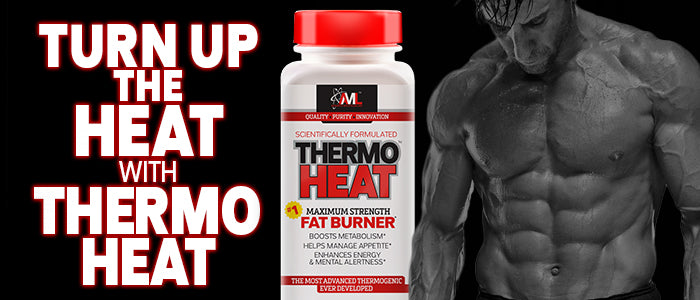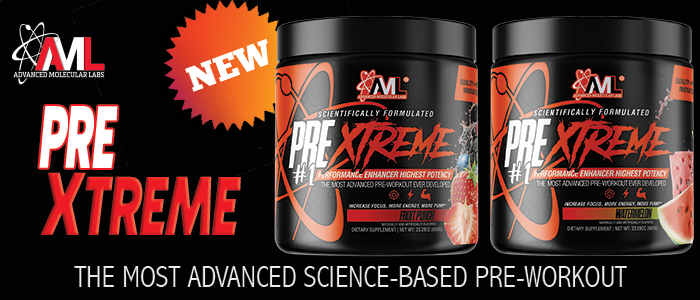


Thermogenic Fat Burners for Belly Fat
The standard weight-loss program typically involves caloric restriction combined with some kind of rigorous exercise program. This generates an energy deficit that prompts the body to burn fat in order to replenish energy, which in due course promotes fat loss. In theory, this approach seems very logical and should work well, but it has been rather ineffective at achieving fat loss based on the fairly high levels of obesity now seen in the United States.1 Furthermore, the typical fat-burning regimen generally involves extensive cardiovascular work that inhibits muscle growth, especially while cutting calories, making this an ineffective choice for those trying to lose fat while maximizing muscle.
BAT Thermogenesis Incinerates Body Fat
Based on the above-mentioned shortcomings, alternate ways to reduce body fat have recently gained considerable interest. One fat-loss target that has emerged as potentially groundbreaking is brown adipose tissue (BAT) or brown fat. BAT normally generates body heat by vigorously burning body fat, by a process known as non-shivering thermogenesis, in response to cold temperature exposure in order to maintain normal body temperature. The ability to burn fat with BAT represents a promising way to improve fat loss. This approach highlights the potential of thermogenic fat burners in enhancing the body's natural fat-burning processes.
BAT is composed of a unique type of fat cell that generates a considerable amount of heat, because of its remarkable capacity to uncouple the normally linked process of fat burning with cellular energy (ATP) production within the mitochondria. As a result, instead of the energy from fat being used to synthesize ATP, it is instead converted into heat. To some degree, all cells can generate heat by thermogenesis, especially when body temperature is below a regulatory threshold. However, BAT is the most proficient thermogenic tissue in the body for two basic reasons. First, each cell has a higher number of mitochondria compared to other cells. Second, these mitochondria have a higher-than-normal concentration of a protein known as uncoupling protein 1 (UCP-1) within their mitochondria. UCP-1, as its name implies, is the protein that directly uncouples fat oxidation with ATP production, producing heat instead.
Interestingly, BAT has been long recognized as a thermogenic organ in other species, yet has only recently been found to exist in adult humans. Despite only recently discovering the existence of BAT in adults, there has been an abundance of scientific inquiry into BAT function that has produced a ton of evidence demonstrating that BAT has a significant regulatory function controlling whole-body energy expenditure and body fat levels in adult humans.2-6 Furthermore, additional research has led to the discovery of many naturally occurring compounds that strongly augment BAT-induced fat burning.
Thermo-Heat Boosts Thermogenesis and Torches Fat!
After toiling through the literature on fat reduction night after night for many years, and contemplating which combination of fat-burning compounds would revolutionize the fat-loss process, Advanced Molecular Labs (AML) and our very own publisher Steve Blechman has put together a formidable blend of these fat-eradicating compounds in his new product, Thermo-Heat, that is going to transform the concept of fat burning in the nutritional supplement world! With immense potential to burn a sizable amount of calories by cranking up thermogenesis, Thermo-Heat is sure to spark considerable fat burning while also lowering the requirement for muscle-depleting cardiovascular exercise and hypocaloric diets, ultimately fostering an uncommon capacity to pack on lean muscle mass. This makes it an effective belly fat burner for those aiming to enhance their physique.
How BAT Sparks Thermogenesis
BAT thermogenesis is typically activated in response to cold exposure by stimulating a receptor molecule in the brain belonging to the transient receptor potential vanilloid (TRPV) family, whose normal function is to regulate body temperature. Cold activation of TRPV within the brain triggers the sympathetic nervous system, resulting in noradrenaline release. Noradrenaline then binds the beta-adrenergic receptor embedded within the cellular membranes of BAT and turns up fatty acid oxidation. In addition, extensive cold stimulation of the sympathetic nervous system elicits an increase in BAT levels as well as BAT activity, which further increases the potential to burn fat and promote fat loss. While prolonged exposure to cold temperatures (60 degrees Fahrenheit) for roughly two hours effectively triggers BAT activity and fat reduction7,8, this approach is rather impractical based on the considerable amount of cold exposure time necessary to trigger BAT activity.
Capsaicin and Capsaicinoids in Thermo-Heat Crank Up Thermogenesis and Fat Loss
Fortunately, there is another way to crank up thermogenesis. Several studies have shown that other members of the TRPV receptor family are activated outside of the brain by various food-related compounds that bind to TRPV receptors within the oral cavity or gastrointestinal tract, yet still activate the sympathetic nervous system and BAT-activated thermogenesis in a very similar fashion to cold exposure. Since these compounds remove the requirement for prolonged cold exposure, they represent a much more practical way to generate BAT-driven fat loss. Among the TRPV activators investigated so far, the most extensively studied has been capsaicin. Capsaicin and capsinoids naturally occur in chili peppers, where they contribute to the hot and spicy flavor of the chili pepper, and are recognized as potent fat burning foods.
The Synergistic Ablation of Fat by Thermo-Heat
In addition to capsaicin and capsinoids, other ingredients found in food possess a powerful stimulatory effect on BAT activity and fat loss, only when combined with capsaicin. Interestingly, these compounds positively influence different components of the TRPV-BAT signaling pathway- making the entire signaling network more cohesive, which boosts the signal for improved BAT activity. As a result, the combined use of these compounds has quite an impact on thermogenic fat loss due to the synergistic response of the TRPV-BAT system to these powerful compound combinations. This synergy is a testament to how natural weight loss supplements can effectively support weight management goals.
While there are many different compounds that activate the TRPV-BAT system, those with a superior influence on BAT-triggered fat loss when combined with capsaicin include two compounds in Thermo-Heat, tyrosine and caffeine. This is despite the fact that neither compound potently stimulates BAT function alone. For instance, one study clearly showed the ineffectiveness of 200 milligrams of caffeine to induce BAT-triggered thermogenesis or weight loss in obese subjects.14 Likewise, tyrosine supplementation alone has also not yet been established as an activator of BAT-stimulated thermogenesis. Even though tyrosine, which is the primary building block of noradrenaline, has been shown to increase noradrenaline and dopamine production and function.15
While the independent consumption of caffeine and tyrosine may ineffectively activate BAT, when consumed with capsaicin they potentiate BAT thermogenesis and fat loss.16 This was clearly demonstrated in a study where the simultaneous consumption of all three compounds- capsaicin, tyrosine and caffeine- for seven days burned additional calories per day.17
This synergism likely occurs because of the complementary effects of all three compounds (capsaicin, tyrosine and caffeine) on the TRPV-BAT system. The direct binding of capsaicin to the TRPV1 receptor triggers the sympathetic nervous system, releasing noradrenaline. Since tyrosine consumption boosts noradrenaline levels, capsaicin-driven release of noradrenaline is increased when combined with tyrosine.18,19 With more adrenaline binding to more beta-adrenergic receptors on BAT, there is a greater production of the molecule cyclic AMP (cAMP) within BAT, which signals greater activation of fat-burning enzymes- thus increasing fatty acid oxidation and thermogenesis in BAT. Finally, the cAMP response, which is typically short-lived because cAMP gets degraded rapidly, is prolonged by caffeine, which directly inhibits the degradation of cAMP and further enhances cAMP activity.
Thermo-Heat Increases BAT Levels
In addition to stimulating BAT activity, another forceful way to harness the thermogenic potential of BAT is by increasing the amount of BAT in the body. A compound naturally found in many fruits and herbs and now found in Thermo-Heat, known as ursolic acid20, has recently been shown to increase BAT levels.21 In addition, this study also showed that ursolic acid increased the expression of UCP-1, which increased thermogenesis, demonstrating that ursolic acid can distinctively increase both BAT quantity and activity. Interestingly, ursolic acid also promotes muscle hypertrophy by activating the IGF-1 signaling cascade.22 Since brown fat and skeletal muscle are derived from the same muscle cell-like precursor cell23 and because IGF-1 signaling promotes brown fat growth24, the authors of this study speculate that ursolic acid increases brown fat and skeletal muscle through a common molecular mechanism involving IGF-1 signaling. Altogether, these results illustrate that ursolic acid has the rather unique capacity to increase the amount and activity of BAT while also boosting muscle growth, which altogether additively increase energy expenditure and reduces body fat.
Thermo-Heat's Beta-Agonist Synephrine More Selectively Activates Thermogenesis Without any of the Side Effects Associated With the Much-Maligned Beta-Agonist Ephedrine Synephrine is an alkaloid found in bitter orange and other citrus fruits including oranges and grapefruits25, and is widely used for weight management. In spite of the widespread consumption and lack of adverse effects associated with synephrine26,27, the safety of synephrine has been incorrectly questioned- in part, because of its chemical similarity to ephedrine, which has been pulled from the market due to safety issues. While both synephrine and ephedrine have similar molecular structures and bind to beta-adrenergic receptors, there are some key molecular differences between these two compounds that change their receptor-binding characteristics, explaining their extremely different safety profiles. It turns out that synephrine and ephedrine bind completely different beta-adrenergic receptors, as only ephedrine binds to beta-adrenergic receptor subtypes beta-1 and beta-2. Since the activation of the beta-1 and beta-2 adrenergic receptors increases vasoconstriction, blood pressure and heart rate28,29, the ability of ephedrine to solely interact with these two receptors illustrates why only ephedrine negatively influences cardiovascular function. Also, recent research has shown that ephedrine does not activate BAT.
Furthermore, other studies show that only synephrine binds mainly beta-3 adrenergic receptors found in BAT30, which are the receptors that activate BAT thermogenesis.31.32 In line with this finding, synephrine was shown in another study to elicit a thermogenic effect by increasing resting metabolic rate, with no effect on heart rate or blood pressure in a double-blind human study.
Thermo-Heat Polyphenols Enhance Thyroid Hormone Fat Burning
A wide variety of polyphenolic compounds have also been shown to possess properties that enhance thermogenesis and fat oxidation. One of them is oleuropein, a polyphenolic found in extra-virgin olive oil, which enhances noradrenaline secretion and increased UCP-1 in BAT.33 Another polyphenolic flavonol with potent thermogenic properties isolated from such divergent sources as tea, broccoli and grapefruit, is the compound kaempferol. In contrast to the previously mentioned compounds, kaempferol activates thermogenesis specifically in muscle cells without triggering noradrenaline release or TRPV receptor activation. Instead, kaempferol stimulates thermogenesis by triggering thyroid hormone production34, which activates a completely different signaling pathway in BAT.
Bile Acids in Thermo-Heat Activate Thermogenesis by Triggering Thyroid Hormone Activity
Recently, it was reported that supplementation with bile acids confers resistance to diet-induced obesity by upregulation of thyroid hormone signaling and thermogenesis in brown adipose tissue.35 While bile acids are normally used to emulsify fat for improved digestion, when it comes to activating thermogenesis, bile acids function as a signaling molecule that bind to the TGR-5 receptor embedded in the cellular membrane of BAT. This signal escalates the expression of the enzyme deiodinase, which catalyzes the production of the active thyroid hormone triiodothyronine or T3. Greater T3 results in the stimulation of UCP-1 production and BAT thermogenesis. Among the many different hormones in the body, thyroid hormones, like T3, are some of the most potent fat burners- yet harnessing their action has proven to be difficult, while also being associated with some harmful side effects. So, the ability of Thermo-Heat's bile acids to regulate thyroid hormone function represents a breakthrough approach that could safely and effectively regulate thyroid hormones and their ability to burn fat. For more information on the impressive influence of bile acids on fat loss, see the "Fat Attack" article by Dr. Dan Gwartney in this issue of Muscular Development.
For more information on Thermo-Heat, thermogenesis and fat burning, go to www.advancedmolecularlabs.com.
For most of Michael Rudolph's career he has been engrossed in the exercise world as either an athlete (he played college football at Hofstra University), personal trainer or as a Research Scientist (he earned a B.Sc. in Exercise Science at Hofstra University and a Ph.D. in Biochemistry and Molecular Biology from Stony Brook University). After earning his Ph.D., Michael investigated the molecular biology of exercise as a fellow at Harvard Medical School and Columbia University for over eight years. That research contributed seminally to understanding the function of the incredibly important cellular energy sensor AMPK- leading to numerous publications in peer-reviewed journals including the journal Nature. Michael is currently a scientist working at the New York Structural Biology Center doing contract work for the Department of Defense on a project involving national security.
References:
1. Haslam, D. Obesity: a medical history. Obes Rev 8 Suppl 2007;1, 31-36.
2. Nedergaard J, Bengtsson T and Cannon B. Unexpected evidence for active brown adipose tissue in adult humans. Am J Physiol Endocrinol Metab 2007;293, E444-452.
3. Saito M, Okamatsu-Ogura Y, et al. High incidence of metabolically active brown adipose tissue in healthy adult humans: effects of cold exposure and adiposity. Diabetes 2009;58, 1526-1531.
4. van Marken Lichtenbelt WD, Vanhommerig JW, et al. Cold-activated brown adipose tissue in healthy men. N Engl J Med 2009;360, 1500-1508.
5. Virtanen KA, Lidell ME, et al. Functional brown adipose tissue in healthy adults. N Engl J Med 2009;360, 1518-1525.
6. Cypess AM, Lehman S, et al. Identification and importance of brown adipose tissue in adult humans. N Engl J Med 2009;360, 1509-1517.
7. Yoneshiro T, Aita S, et al. Brown adipose tissue, whole-body energy expenditure, and thermogenesis in healthy adult men. Obesity 2011 (Silver Spring);19, 13-16.
8. Yoneshiro T, Aita S, et al. Recruited brown adipose tissue as an antiobesity agent in humans. J Clin Invest 2013;123, 3404-3408.
9. Snitker S, Fujishima Y, et al. Effects of novel capsinoid treatment on fatness and energy metabolism in humans: possible pharmacogenetic implications. Am J Clin Nutr 2009;89, 45-50.
10. Whiting S, Derbyshire E and Tiwari B.K. Capsaicinoids and capsinoids. A potential role for weight management? A systematic review of the evidence. Appetite 2012;59, 341-348.
11. Ludy MJ, Moore GE and Mattes RD. The effects of capsaicin and capsiate on energy balance: critical review and meta-analyses of studies in humans. Chem Senses 2012;37, 103-121.
12. Yoneshiro T, Aita S, et al. Nonpungent capsaicin analogs (capsinoids) increase energy expenditure through the activation of brown adipose tissue in humans. Am J Clin Nutr 2012;95, 845-850.
13. Saito M and Yoneshiro T. Capsinoids and related food ingredients activating brown fat thermogenesis and reducing body fat in humans. Curr Opin Lipidol 2013;24, 71-77.
14. Astrup A, Breum L, et al. The effect and safety of an ephedrine/caffeine compound compared to ephedrine, caffeine and placebo in obese subjects on an energy restricted diet. A double blind trial. Int J Obes Relat Metab Disord 1992;16, 269-277.
15. Hull KM and Maher TJ. Effects of L-tyrosine on mixed-acting sympathomimetic-induced pressor actions. Pharmacol Biochem Behav 1992;43, 1047-1052.
16. Yoshioka M, Doucet E, et al. Combined effects of red pepper and caffeine consumption on 24 h energy balance in subjects given free access to foods. Br J Nutr 2001;85, 203-211.
17. Belza A and Jessen AB. Bioactive food stimulants of sympathetic activity: effect on 24-h energy expenditure and fat oxidation. Eur J Clin Nutr 200559, 733-741.
18. Caterina MJ, Leffler A, et al. Impaired nociception and pain sensation in mice lacking the capsaicin receptor. Science 2000;288, 306-313.
19. Vogel G. Hot pepper receptor could help manage pain. Science 2000;288, 241-242.
20. Jager S, Trojan H, et al. Pentacyclic triterpene distribution in various plants - rich sources for a new group of multi-potent plant extracts. Molecules 2009;14, 2016-2031.
21. Kunkel SD, Elmore CJ, et al. Ursolic acid increases skeletal muscle and brown fat and decreases diet-induced obesity, glucose intolerance and fatty liver disease. PLoS One 2012;7, e39332.
22. Kunkel SD, Suneja M, et al. mRNA expression signatures of human skeletal muscle atrophy identify a natural compound that increases muscle mass. Cell Metab 2011;13, 627-638.
23. Kajimura S, Seale P and Spiegelman BM. Transcriptional control of brown fat development. Cell Metab 2010;11, 257-262.
24. Tseng YH, Butte AJ, et al. Prediction of preadipocyte differentiation by gene expression reveals role of insulin receptor substrates and necdin. Nat Cell Biol 2005;7, 601-611.
25. Nelson BC, Putzbach K, et al. Mass spectrometric determination of the predominant adrenergic protoalkaloids in bitter orange (Citrus aurantium). J Agric Food Chem 2007;55, 9769-9775.
26. Stohs SJ. Lack of evidence that p-synephrine is responsible for STEMI. Tex Heart Inst J 2010;37, 383; author reply 383-384.
27. Stohs SJ, Preuss HG and Shara M. The safety of Citrus aurantium (bitter orange) and its primary protoalkaloid p-synephrine. Phytother Res 2011;25, 1421-1428.
28. Jordan R, Midgley JM, et al. Beta-adrenergic activities of octopamine and synephrine stereoisomers on guinea-pig atria and trachea. J Pharm Pharmacol 1987;39, 752-754.
29. Hibino T, Yuzurihara M, et al. Synephrine, a component of Evodiae Fructus, constricts isolated rat aorta via adrenergic and serotonergic receptors. J Pharmacol Sci 2009;111, 73-81.
30. Shannon JR, Gottesdiener K, et al. Acute effect of ephedrine on 24-h energy balance. Clin Sci 1999 (Lond);96, 483-491.
31. Arch JR. beta(3)-Adrenoceptor agonists: potential, pitfalls and progress. Eur J Pharmacol 2002;440, 99-107.
33. Oi-Kano Y, Kawada T, et al. Oleuropein, a phenolic compound in extra virgin olive oil, increases uncoupling protein 1 content in brown adipose tissue and enhances noradrenaline and adrenaline secretions in rats. J Nutr Sci Vitaminol (Tokyo) 2008;54, 363-370.
34. da-Silva WS, Harney JW, et al. The small polyphenolic molecule kaempferol increases cellular energy expenditure and thyroid hormone activation. Diabetes 2007;56, 767-776.
35. Watanabe M, Houten SM, et al. Bile acids induce energy expenditure by promoting intracellular thyroid hormone activation. Nature 2006;439, 484-489.




